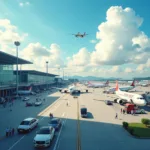Airport Design is a complex and multifaceted process that involves the creation of efficient, safe, and sustainable air transportation hubs. It encompasses a wide range of considerations, from runway layout and terminal building design to airspace management and ground transportation infrastructure. This guide will delve into the key aspects of airport design, exploring the intricacies of planning and building modern airports to meet the demands of 21st-century air travel.
Understanding the Core Principles of Airport Design
Effective airport design begins with a thorough understanding of several core principles. These principles guide every stage of the process, ensuring the final product is not only functional but also aesthetically pleasing and environmentally responsible. A key principle is capacity planning, which involves predicting future passenger and cargo volumes to determine the appropriate size and scale of the airport. This includes considering factors like aircraft movements, passenger flow, and baggage handling requirements. Another crucial principle is safety and security, integrating robust measures to protect passengers, personnel, and aircraft from threats. Finally, sustainability plays an increasingly vital role, focusing on minimizing the airport’s environmental impact through energy efficiency, waste management, and noise reduction strategies.
 Airport Design Planning Process
Airport Design Planning Process
Master Planning: The Blueprint for Airport Development
The master plan serves as the blueprint for airport development, outlining the long-term vision and strategy for the airport’s growth and evolution. This comprehensive document considers future demand forecasts, land use constraints, and environmental considerations. A well-developed master plan provides a framework for phased construction, ensuring that the airport can adapt to changing needs and technologies over time. It also addresses the integration of the airport with the surrounding community, minimizing disruptions and maximizing economic benefits. The master plan is essential for securing funding and obtaining necessary approvals from regulatory bodies. Much like architectural blueprints for a building, the airport master plan lays the foundation for a successful and sustainable future.
Similar to the hisar airport design, the planning phase is crucial for any airport development project.
Runway and Taxiway Design: Ensuring Efficient Aircraft Movement
Runway and taxiway design is a critical element of airport design, directly impacting the airport’s capacity and operational efficiency. The length and width of runways are determined by the types of aircraft expected to use the airport, while the layout of taxiways must minimize taxiing times and ensure smooth traffic flow. Factors like wind direction, terrain, and obstacle clearance are also taken into consideration. Modern airport design often incorporates advanced technologies like runway incursion warning systems and ground radar to enhance safety and efficiency.
 Airport Runway and Taxiway Layout
Airport Runway and Taxiway Layout
Terminal Building Design: Creating a Seamless Passenger Experience
The terminal building serves as the gateway to the airport, and its design plays a vital role in shaping the passenger experience. A well-designed terminal provides a smooth and intuitive flow for passengers, from check-in and security screening to baggage claim and ground transportation. Considerations like passenger comfort, accessibility, and retail opportunities are paramount. Modern terminal designs often incorporate natural light, spacious waiting areas, and convenient amenities to create a welcoming and stress-free environment for travelers.
2d airports plans design hd photos can be a valuable resource for visualizing and understanding various airport layouts.
Integrating Technology and Sustainability in Airport Design
Modern airport design increasingly embraces technology and sustainable practices. From automated baggage handling systems and self-service kiosks to energy-efficient lighting and rainwater harvesting, technology and sustainability are transforming the way airports are designed and operated. These innovations not only improve efficiency and reduce costs but also contribute to a more sustainable future for air travel. The integration of smart technologies, such as real-time passenger information systems and predictive analytics, enhances the overall passenger experience and optimizes airport operations.
 Sustainable Airport Design Features
Sustainable Airport Design Features
Conclusion: The Future of Airport Design
Airport design continues to evolve, driven by the increasing demands of air travel and the need for sustainable solutions. As passenger volumes grow and technology advances, airport design will play a critical role in shaping the future of air travel. By embracing innovation and prioritizing passenger experience, airports can become more than just transportation hubs; they can become vibrant gateways to the world.
As an example, the bhogapuram airport design showcases some of these forward-thinking principles.
FAQ
- What is the typical lifespan of an airport master plan?
- What are the key factors considered in runway orientation?
- How does airport design accommodate different aircraft sizes?
- What are some examples of sustainable airport design features?
- How does airport design address passenger accessibility?
- What are the main challenges in designing airport terminals?
- How does technology impact airport design and operations?
Looking for more detailed information on airport vector graphics? Check out our airport vector page.
Need help with 3D design services for your airport project? Contact our recommended 3d designer company at indira gandhi international airport delhi.
For any assistance with airport design, please contact us at Phone: +13089626264, Email: [email protected] or visit us at 404 Bothwell St, Oxford, NE 68967, USA. We have a 24/7 customer service team available to assist you.

